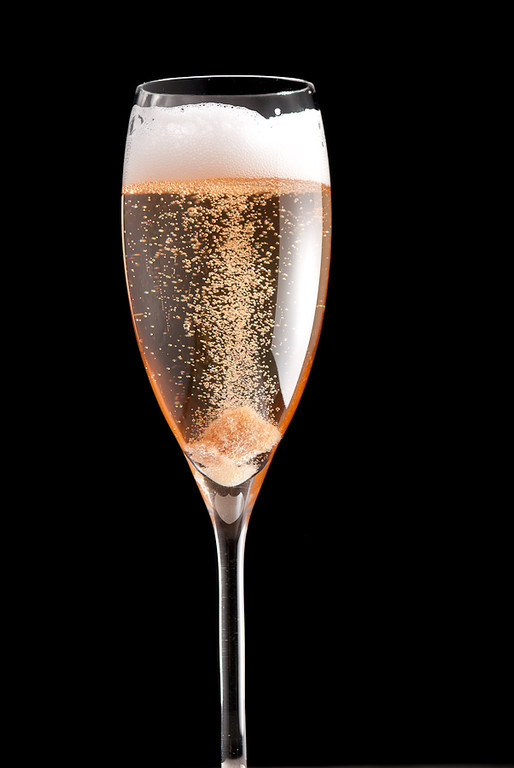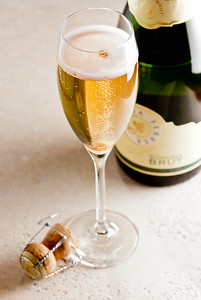OK, so you have champagne for your New Year’s brunch. Seems a little blah, doesn’t it? Try the Champagne Cocktail instead.
The Champagne Cocktail is one of the oldest of cocktails, and one of the quickest and easiest to make. It turns a glass of everyday champagne into a much more sophisticated flavor treat.
It is as simple as adding sugar and bitters to a glass of champagne. This would have been a sweet cocktail when it was invented in the first half of the eighteenth century; the drier “brut” champagnes so familiar today didn’t become popular until the 1880s and ’90s.
The drink would have been pretty flat, too—Jerry Thomas’s 1887 Bartender’s Guide calls for it to be shaken with ice before serving. This is not my idea of a good way to treat any kind of sparkling wine, and apparently others came to that conclusion, too. By the end of the century, shaking and stirring were deprecated, and brut champagnes were the Champagne style of choice.

- 1 sugar cube (or ½ tsp granulated sugar)
- 1–2 dashes Angostura bitters (or other aromatic bitters of choice)
- 5 oz mid-range champagne (or prosecco, cava, etc.)
- ½ oz cognac (optional variation, see note below)
Put the sugar in the bottom of a champagne flute, and soak it with the bitters. Top up the glass with sparkling wine.
This is a fine place to use decent, middle-of-the-road sparkling wines. You can use dry midrange champagnes to good advantage in this drink; proseccos and cavas work very nicely, too.
 Bitters are the heart of the Champagne Cocktail. They have a pronounced influence on the final flavor. They balance the sweetness of the champagne, and introduce herbs and spices that give the drink a completely different character from that presented by the wine itself.
Bitters are the heart of the Champagne Cocktail. They have a pronounced influence on the final flavor. They balance the sweetness of the champagne, and introduce herbs and spices that give the drink a completely different character from that presented by the wine itself.
The sugar cube is part of the fun of this drink, present mainly for entertainment value. It dissolves very slowly, and encourages a constant turmoil of bubbles in the champagne. It does have a slight sweetening effect on the drink, but since it dissolves so slowly, it is barely noticeable until you get to the end of the glass, where a little pool of simple syrup forms with time. (It intrigued me to discover that, while I find undissolved sugar off-putting in something like a Whiskey Old-Fashioned, its bubble-inducing presence in the Champagne Cocktail seems more amusing.)
The Champagne Cocktail has changed very little since the Gay ’90s, when the drier champagnes caught on, and the bubble-flattening shaking and stirring finally fell off the instruction list.
There is one embellishment of note, one that you don’t encounter very often: the addition of a small amount of cognac to the mix. David Wondrich attributes this variant to Joseph Hayward, a Delaware barman who first recorded it in 1898. This version is absolutely delicious, and I recommend it highly. (Hayward added an ounce of brandy; I prefer less, about a half-ounce.)
“The Champagne Cocktail” at cold-glass.com : All text and photos © 2011 Douglas M. Ford. All rights reserved.

Reblogged this on The Paper Trail and commented:
Happy new year friends!!
Interestingly, I would say that Champagne Cocktails on this side of the pond almost invariably include the brandy, so much so that I’ve never encountered the cognac-free version wherever I or a companion has ordered one.
Even more tellingly, the brandy is so ubiquitous here that I’ve never even thought to omit it on the rare occasions I’ve made one myself. I think I prefer the sound of the brandy-less version, to be honest, and will certainly try it out!
I hadn’t considered before that there may be a geographic preference for including the brandy. I learn something every day.
The drink has a simpler flavor without brandy, and the characteristics of the bitters influence the flavor more directly. Including brandy makes a better blended cocktail, I think. And I’m not the only one: David Wondrich, in Imbibe!, claims to be “shamefully partial to the hot-rails-to-hell practice…” He cracks me up.
Great line. :)
Here’s another (slight) variation. I don’t generally have sugar cubes available, so use a small amount of coarsely-granulated demerara sugar instead. Still gives something for bubbles to form on at the bottom and a (little) more dissolves into the drink compared to cubes. More significantly, what does dissolve imparts some of that rich demerara flavour. It complements the bitters quite nicely. I suspect that without the brandy in the drink, I’d notice it even more.
Sounds delicious! Can’t wait to try! Happy New Year!!!
I just tried this cocktail at my favorite bar in San Francisco…& coincidentally it was the first time my favorite bartender had ever made this drink. Sweet cow, it was sooooooo delicious!
Yes, it’s a good version of champagne. I hope your bartender spreads the word.
You mention Wondrich’s comments on this; have you gotten around to trying the cider variation he mentions–the Jersey? I’ve been wondering how that would be with applejack or calvados substituted for the cognac. Maybe too much of a good thing.
Also, you can get Demerara sugar cubes on Amazon, if you ever want to experiment with those.
No, I haven’t tried the cider variation—I forgot all about that one. Now you have me thinking about it again. I like the idea of subbing calvados for the champagne, it’s certainly worth a try. Then perhaps a bitters with a bit more cinnamon or pie spices than the Angostura. A fine drink for harvest time, perhaps?
Good idea on the Demerara cubes; as a matter of fact, I found some at my local grocery, good sized box that will probably be a lifetime supply! Thanks for the Amazon idea.